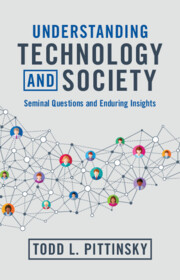Refine search
Actions for selected content:
599 results
5 - Theology as a Science
- from Part II - Theological Themes
-
-
- Book:
- The Origins of Scholasticism
- Published online:
- 18 November 2025
- Print publication:
- 31 December 2025, pp 157-182
-
- Chapter
- Export citation
7 - Medicine, Science, and the Environment
-
-
- Book:
- Explaining the History of American Foreign Relations
- Published online:
- 24 October 2025
- Print publication:
- 13 November 2025, pp 139-160
-
- Chapter
- Export citation
Banking on research: Who leads? Who follows? Who cares?
-
- Journal:
- Journal of Institutional Economics / Volume 21 / 2025
- Published online by Cambridge University Press:
- 10 November 2025, e42
-
- Article
-
- You have access
- Open access
- HTML
- Export citation
Chapter 8 - ‘How to cultivate a love for reading’
- from Part II - Readers and Audiences
-
-
- Book:
- African Literature in Transition
- Published online:
- 23 October 2025
- Print publication:
- 06 November 2025, pp 166-183
-
- Chapter
- Export citation
3 - ‘The Glory of their times’: Natural Philosophy, the Law, and the Spoils of Empire
-
- Book:
- The University of Cambridge in the Age of Atlantic Slavery
- Published online:
- 12 September 2025
- Print publication:
- 30 October 2025, pp 76-103
-
- Chapter
-
- You have access
- Open access
- HTML
- Export citation
Chapter 4 - Bloomsbury and the New Biography
- from Part I - Aesthetic Bloomsbury
-
-
- Book:
- A History of the Bloomsbury Group
- Published online:
- 09 October 2025
- Print publication:
- 23 October 2025, pp 52-67
-
- Chapter
- Export citation
Introduction
-
-
- Book:
- Science and Humanism
- Published online:
- 09 October 2025
- Print publication:
- 23 October 2025, pp 1-8
-
- Chapter
-
- You have access
- Open access
- HTML
- Export citation
Chapter 23 - Bloomsbury and Science
- from Part IV - Public Bloomsbury
-
-
- Book:
- A History of the Bloomsbury Group
- Published online:
- 09 October 2025
- Print publication:
- 23 October 2025, pp 383-398
-
- Chapter
- Export citation
Chapter 2 - Varieties of Philosophical Humanism and Conceptions of Science
- from Part I - Interrelations
-
-
- Book:
- Science and Humanism
- Published online:
- 09 October 2025
- Print publication:
- 23 October 2025, pp 36-59
-
- Chapter
-
- You have access
- Open access
- HTML
- Export citation
Chapter 1 - What Is Science For?
- from Part I - Interrelations
-
-
- Book:
- Science and Humanism
- Published online:
- 09 October 2025
- Print publication:
- 23 October 2025, pp 11-35
-
- Chapter
-
- You have access
- Open access
- HTML
- Export citation
Contemporary censors at work: targeting medical science to shape social reality
-
- Journal:
- The British Journal of Psychiatry , FirstView
- Published online by Cambridge University Press:
- 22 October 2025, pp. 1-3
-
- Article
-
- You have access
- HTML
- Export citation
21 - Medical and Scientific Writing
- from Part III - Genre and Medium in the Record
-
-
- Book:
- The New Cambridge History of the English Language
- Published online:
- 18 October 2025
- Print publication:
- 16 October 2025, pp 506-533
-
- Chapter
- Export citation
Chapter 4 - Empiricism and Kantian Accounts of Thought Experiment
- from Part I - The Origins of “Thought Experiment” in Kant and Ørsted
-
- Book:
- Kierkegaard and the Structure of Imagination
- Published online:
- 26 September 2025
- Print publication:
- 16 October 2025, pp 63-75
-
- Chapter
- Export citation

Science and Humanism
- Knowledge, Values, and the Common Good
-
- Published online:
- 09 October 2025
- Print publication:
- 23 October 2025
-
- Book
-
- You have access
- Open access
- Export citation
Conclusion
-
- Book:
- Risk and Resistance
- Published online:
- 10 September 2025
- Print publication:
- 09 October 2025, pp 145-151
-
- Chapter
- Export citation
6 - Knowledge, Technology Transfer and Convergence
-
- Book:
- An Economic History of Europe
- Published online:
- 02 October 2025
- Print publication:
- 02 October 2025, pp 132-154
-
- Chapter
- Export citation

Understanding Technology and Society
- Seminal Questions and Enduring Insights
-
- Published online:
- 30 September 2025
- Print publication:
- 10 July 2025
Chapter 10 - Theory of Demonstration
-
-
- Book:
- Ockham’s <i>Summa Logicae</i>
- Published online:
- 04 September 2025
- Print publication:
- 18 September 2025, pp 210-230
-
- Chapter
- Export citation
Chapter 11 - Synge, Modernity, and the Myth of Revival
- from Part III - Mythologies of the Literary Revival
-
-
- Book:
- The Revival in Irish Literature and Culture
- Published online:
- 04 September 2025
- Print publication:
- 18 September 2025, pp 222-238
-
- Chapter
- Export citation
Chapter 10 - Science
- from Part II - Themes and Issues
-
-
- Book:
- The Cambridge Companion to Modernist Theatre
- Published online:
- 28 August 2025
- Print publication:
- 11 September 2025, pp 180-197
-
- Chapter
- Export citation
